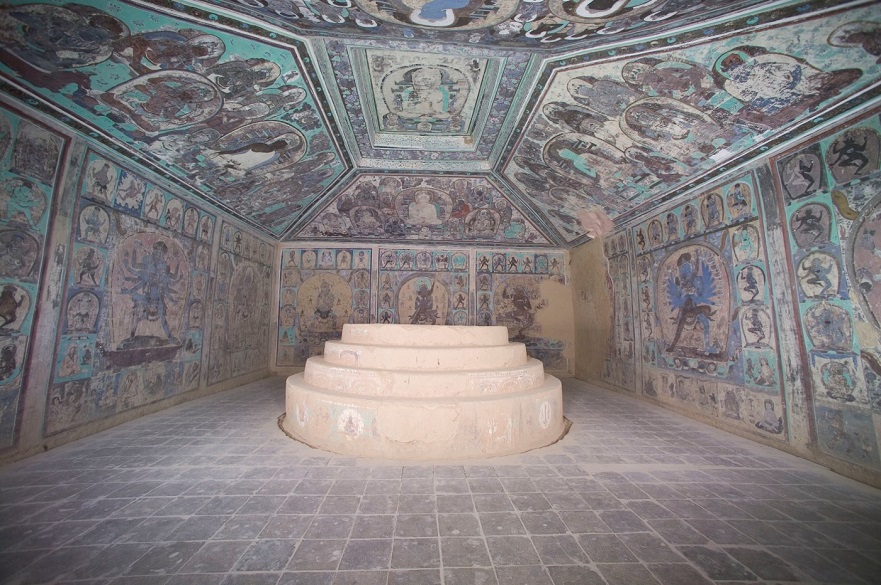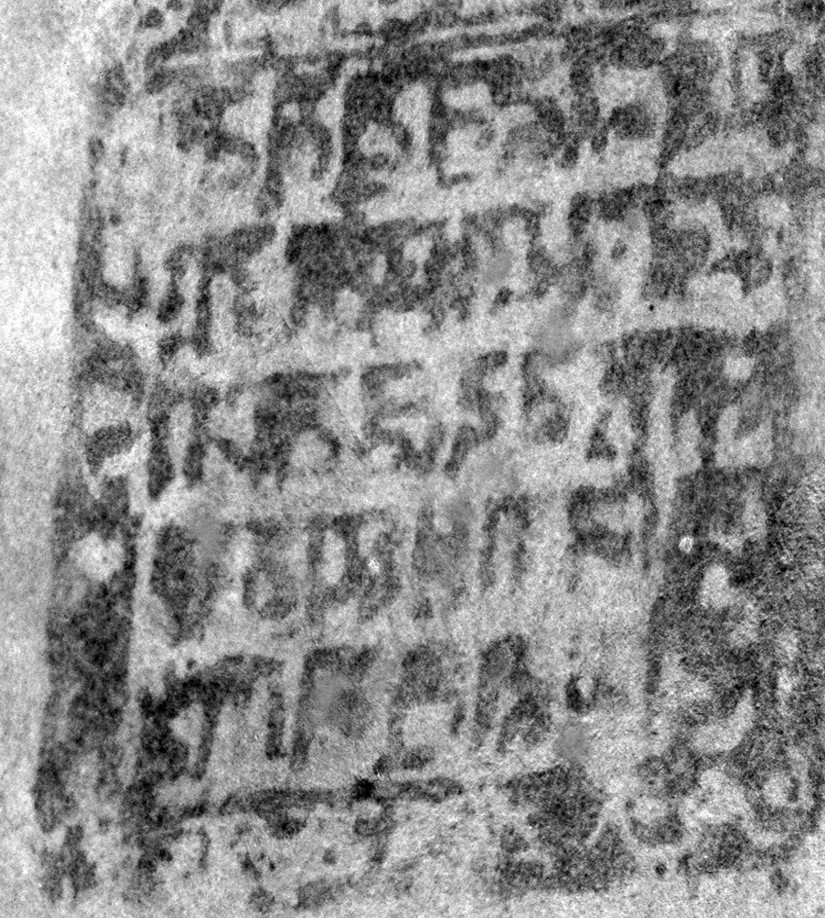Scientists reveal 700-year-old cave’s hidden secrets
Researchers studying ancient wall paintings in a Tibetan Buddhist cave temple in north west China made a surprising discovery, when they uncovered a prayer written in Sanskrit which they believe may have been accidentally pasted onto the ceiling upside down by workers more than 700 years ago.
By Dave Rogers | Published on 17 November 2020
Categories: Press office; Research; School of Science and Technology;

A team led by Nottingham Trent University’s Imaging and Sensing for Archaeology, Art history and Conservation (ISAAC) Lab has been trying to accurately date the paintings in a cave on the ancient Silk Road by using a range of analytical techniques to identify different paint materials and faded writings.
The work, which has involved astronomy imaging techniques, machine learning processes, art history analysis and palaeography, is focused on the Mogao Caves in Dunhuang, a UNESCO World Heritage Site on the edge of the Gobi Desert, which have a history of more than 1,000 years.
The date of the paintings in ‘Cave 465’ – one of 492 painted Buddhist cave temples dating from the 4th to the 14th Century – has long been debated by historians and archaeologists. Suggestions range over 500 years and across three different empires: from 9th Century Tibetan, to 11th-13th Century Tangut, to the 13th-14th Century Mongol/Yuan period.
Because the paintings are vulnerable, the caves have high ceilings and inspection needs to be carried out non-invasively, the research team used their own automated 3D spectral imaging system which allows for high-resolution imaging of paintings to be conducted from the ground.
The system – which allows the study of painting techniques, can identify the colour pigments used at the time based on their spectral signatures and reveals faded writings not visible to the naked eye – is able to carry out remote spectral imaging of large painted areas in high resolution from distances of tens of meters. It then uses a machine-learning method to automatically process the large volume of data.
All of this can be used to help date a piece of work.
As part of the study, which is published in the journal Scientific Reports, the team was able to date the paintings from late 12th to 13th Century.
While investigating the Tibetan tantric Buddhist cave temple, which is painted with the Five Celestial Buddhas on the ceilings, they were able to unveil identical faded writings at the foot of each of the Buddha images.
These were printed or stamped Sanskrit text in cinnabar – a mineral which was used to create a red pigment - just a few centimetres square on a piece of paper which was then pasted on the ceiling.
Analysis revealed that the sheet of paper on the west ceiling appeared to have been accidentally glued face down as the letters had been flipped and the red writing was barely visible at all.
The text on the paper was identified as a Buddhist Sanskrit phrase known as the “Summary of Dependent Origination" – considered a summary of the teachings of the Buddha, it can be translated as: “All things arise from causes.”

The revealed text, thought to have been accidentally glued face down about 700 years ago
The pasting of the paper sheet with the Sanskrit mirrors how the text is used in other contexts across the Buddhist world in the consecration of statues and painted figures. Printed texts of the same phrase in a similar script have also been found inside other caves dated to the Mongol/Yuan period.
The work also involved palaeography – the study of the evolution of writing over time – which identified certain letters which were not written in the way depicted until after the late 12th Century.
A number of the caves, thought to be iconic of the three different periods, were selected as comparison caves before an analysis of the paint materials showed that the pigment combinations used were also mostly consistent with the Mongol / Yuan period.
Gypsum and dolomite were used to make white, while orpiment was used to make yellow in this cave. In the Tibetan period caves, gypsum was never used for white, while yellow was not found in any of the Tangut period caves. Yellow was used in a Tibetan period cave, but only using yellow ochre pigment rather than orpiment.
“This has been a huge debate for many years, but now our analysis has enabled us to date this cave with much more certainty than ever before,” said Professor Haida Liang, Head of the Imaging & Sensing for Archaeology, Art History & Conservation research group at Nottingham Trent University.
She said: “The written paper prints seem to have been produced and pasted on the ceiling during the construction of the cave temple, as part of a consecration ritual. That was a fascinating discovery, we believe it was a mistake, perhaps the workmen who put it up didn’t understand Sanskrit.
“With regards to the colours used, our work relies on understanding what is a particular mix for a particular period. Each material mix is a fingerprint.
“Taking into consideration all the evidence that we have been able to gather as part of this work, the date of the Cave 465 wall paintings must be from the late 12th to the 13th century.”
The study also involved the Dunhuang Research Academy in China and The British Library.
Notes for Editors
Press enquiries please contact Dave Rogers, Public Relations Manager, on telephone +44 (0)115 848 8782, or via email.
NTU was named University of the Year 2019 in the Guardian University Awards. The award was based on performance and improvement in the Guardian University Guide, retention of students from low-participation areas and attainment of BME students. NTU was also the Times Higher Education University of the Year 2017, and The Times and Sunday Times Modern University of the Year 2018. These awards recognise NTU for its high levels of student satisfaction, its quality of teaching, its engagement with employers, and its overall student experience.
The university has been rated Gold in the Government’s Teaching Excellence Framework – the highest ranking available.
It is one of the largest UK universities. With nearly 32,000 students and more than 4,000 staff located across four campuses, the University contributes £900m to the UK economy every year. With an international student population of more than 3,000 from around 100 countries, the University prides itself on its global outlook
The university is passionate about creating opportunities and its extensive outreach programme is designed to enable NTU to be a vehicle for social mobility. NTU is among the UK’s top five recruiters of students from disadvantaged backgrounds and was awarded University of the Year in the UK Social Mobility Awards 2019. A total of 82% of its graduates go on to graduate entry employment or graduate entry education or training within six months of leaving. Student satisfaction is high: NTU achieved an 87% satisfaction score in the 2019 National Student Survey.
A total of 82% of its graduates go on to graduate entry employment or graduate entry education or training within six months of leaving. Student satisfaction is high: NTU achieved an 87% satisfaction score in the 2019 National Student Survey.